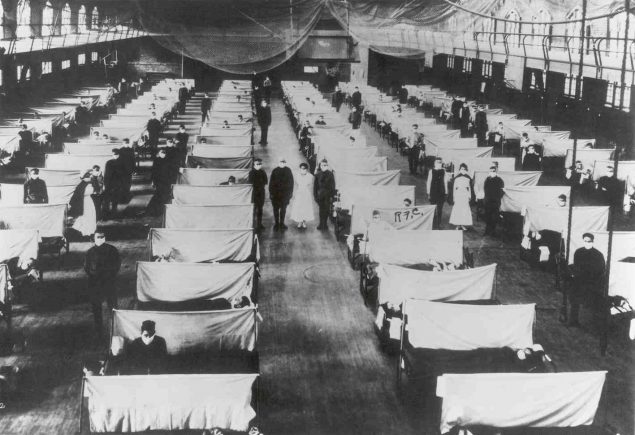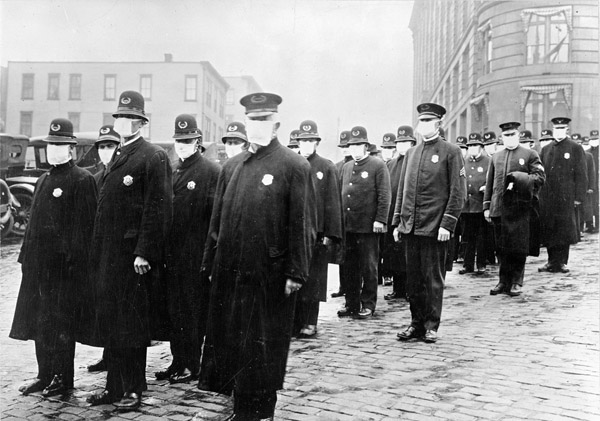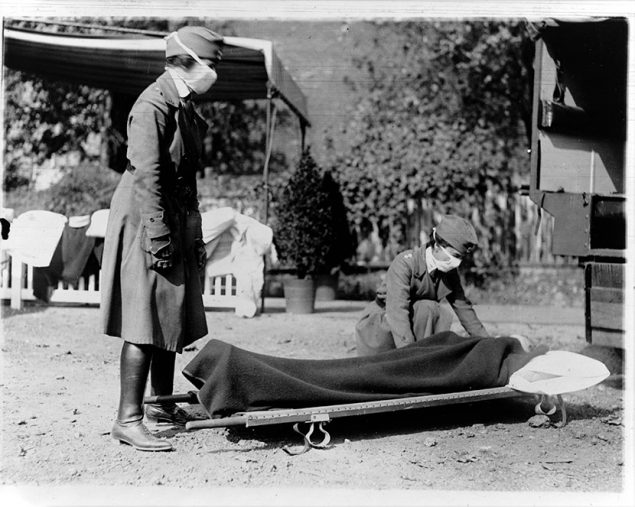1918 Pandemic Influenza Historic Timeline
In 1918, a new influenza virus emerged. During this same time period World War I was taking place. The conditions of World War I (overcrowding and global troop movement) helped the 1918 flu spread. The vulnerability of healthy young adults and the lack of vaccines and treatments created a major public health crisis, causing at least 50 million deaths worldwide, including approximately 675,000 in the United States. Below is a historical timeline of major events that took place during this time period.
April 1917
- U.S. enters World War I with 378,000 in the armed services.
June 1917
- A draft is established to increase the number of soldiers; Army begins training recruits at 32 large camps, each housing 25,000 to 55,000 soldiers.
March 1918

- Outbreaks of flu-like illness are first detected in the United States.
- More than 100 soldiers at Camp Funston in Fort Riley, Kansas become ill with flu. Within a week the number of flu cases quintuples.
- Sporadic flu activity spreads unevenly through the United States, Europe, and possibly Asia over the next six months.
April 1918
- First mention of influenza appears in an April 5 weekly public health report. The report informs officials of 18 severe cases and three deaths in Haskell, Kansas.
May 1918
- By May, hundreds of thousands of soldiers travel across the Atlantic each month as they are deployed for World War I.
September 1918

- The second wave of flu emerges at Camp Devens, a United States Army training camp just outside of Boston, and at a naval facility in Boston.
- Between September and November, a second wave of flu peaks in the United States. This second wave is highly fatal, and responsible for most of the deaths attributed to the pandemic.
- New York City’s Board of Health adds flu to the list of reportable diseases, and requires all flu cases to be isolated at home or in a city hospital.
- By the end of September, more than 14,000 flu cases are reported at Camp Devens—equaling about one-quarter of the total camp, resulting in 757 deaths.
October 1918
- The 1918 flu pandemic virus kills an estimated 195,000 Americans during October alone.
- In fall of 1918 the United States experiences a severe shortages of professional nurses, because of the deployment of large numbers of nurses to military camps in the United States and abroad, and the failure to use trained African American nurses.
- Chicago chapter of the American Red Cross issues urgent call for volunteers to help nurse the ill.
- Philadelphia is hit hard with the pandemic flu viruses—more than 500 corpses await burial, some for more than a week. Cold-storage plants are used as temporary morgues, a manufacturer of trolley cars donates 200 packing crates for use as coffins.
- Chicago, along with many other cities across the United States, closes theaters, movie houses and night schools and prohibit public gatherings.
- San Francisco’s Board of Health requires any person serving the public to wear masks and issues strong recommendation to all residents to wear masks in public.
- New York City reports a 40 percent decline in shipyard productivity due to flu illnesses in the midst of World War I.
November 1918

- The end of World War I enables a resurgence of influenza as people celebrate Armistice Day and soldiers begin to demobilize.
- Salt Lake City officials place quarantine signs on front and rear doors of 2,000 homes where occupants have been struck with flu.
- By the end of World War I the U.S. military grew in size from 378,000 soldiers in April 1918 to 4.7 million soldiers.
December 1918
- Public health officials begin education programs and publicity about dangers of coughing and sneezing; careless disposal of “nasal discharges.”
- Committee of the American Public Health Association encourages stores and factories to stagger opening and closing hours and for people to walk to work when possible instead of using public transport to prevent overcrowding.
January 1919

- A third wave of influenza occurs in the winter and spring of 1919, killing many more. Third wave subsides in the summer.
- In San Francisco, 1,800 flu cases and 101 deaths are reported in first five days of January.
- Many San Antonio citizens begin complaining that new flu cases aren’t being reported, and that this is fueling another influenza surge.
- Seven-hundred and six cases of influenza and 67 deaths are reported in New York City, triggering fear of a recurrence of severe flu activity.
- Trustees of the Boston City Hospital ask mayor for a special appropriation of $3,000 to study the treatment of influenza.
February 1919
- Influenza appears to be nearly eradicated in New Orleans as number of reported cases drops.
- Illinois passes a bill to create a one-year course to become a “practical nurse,” an effort to address the nursing shortage the pandemic had exposed.
April 1919
- At Versailles Peace Conference, while negotiating the end of World War I with other world leaders, U.S. President Woodrow Wilson collapses. Some historians speculate he was weak from influenza, which was still rampant in Paris.